#picow
Photo

Let's build a Raspberry Pi Pico Home Automation. Stay tuned.... #rpi #raspberry #pico #pipico #raspberrypipico #automation #relay #picow #diode #pcb #transistor #homeautomationsystem #homeautomation #relay #rp2040 https://www.instagram.com/p/CnhR5r1PEM-/?igshid=NGJjMDIxMWI=
#rpi#raspberry#pico#pipico#raspberrypipico#automation#relay#picow#diode#pcb#transistor#homeautomationsystem#homeautomation#rp2040
2 notes
·
View notes
Text
Use Adafruit IO with a Raspberry Pi Pico W to create IoT dashboards using MQTT #raspberrypi #internetofthings
I decided recently to set up a string of temperature sensors around our house to work out the temperature profile of different rooms.
With the recent release of the Pico W, I realised that I could do this quite simply, as long as I could find a way to “nicely” display the data.
You’ll have read my exploits with Anvil last week, I expect, and saw that I didn’t have much luck. However, I knew that…

View On WordPress
0 notes
Text
Raspberry Pi PicoW - wieviel "W" ist nötig?
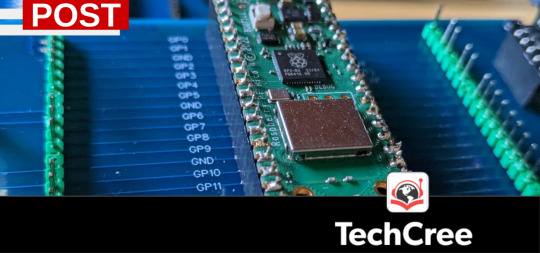
Nach dem Raspberry Pi Pic folgte der Pico W, also die Version auf der ein WLAN Modul verbaut wurde. Doch wieviel "W" ist nötig, genau das ist die Frage?
Es ist natürlich großartig, dass der Raspberry Pi Pico, der Microcontroller der Raspberry Pi Foundation UK nun auch ein WLAN Modul verbaut bekam. Dies ermöglicht es uns den kleinen Microcontroller auch als Mini-Webserver zu nutzen. Meldet er sich in einem WLAN an, so erhält er vom Router eine IP Adresse. Unter dieser kann dann bspw. eine Website aufgerufen werden, wenn der Pico W als Webserevr programmiert wurde.
Eine andere Sache ist, dass durch das WLAN Modul ein Pico W sich nun auch Informationen aus dem Internet beschaffen kann. Beispielsweise um als Uhr zu dienen und wenn es darum geht die richtige Uhrzeit anzeigen zu können. Der Microcontroller selbst kann diese RTC Funktion nur bedingt. Benötigt also den Zugriff auf einen Uhrzeitserver für die RealtimeClock(RTC) Funktion. Diese kann er dann natürlich speichern und sich immer wider die aktuelle Uhrzeit aus dem Netz beschaffen um Up-to-Date zu sein. Also eher up-to-Time.
In den kommenden Wochen soll es dann auch möglich werden Bluetooth (BT) zu nutzen, denn der Microcontroller beherrscht das wohl schon, aber es mangelt derzeit noch an entsprechemdem Code für dessen Betriebssystem, gerade im Thema Micropython besteht da ein Defizit. Bei allem dürfen wir aber nicht vergessen, dass uns da aktuell noch ein wichtiger Punkt fehlt bei dem uns weder WLAN noch BT so recht hiflt. Die drahtlose Programmierung.
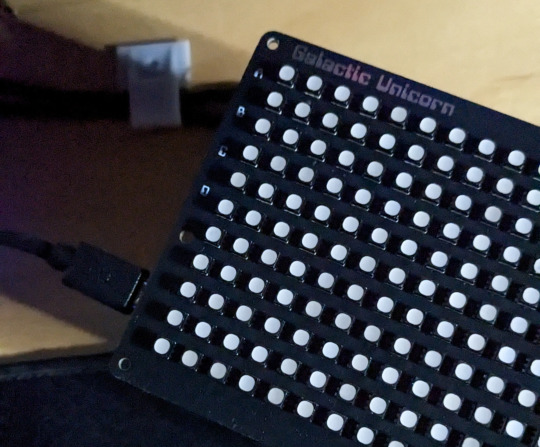

Doch soviel "W" reicht uns nicht! Hier gibt es im Zusammenhang mit Micropython beispeilsweise ein ganz grundlegendes Problem. Wir erreichen es nicht Datein zu ändern solange der Pico/Pico W ein Script ausführt und zudem bleibt die Programmierung über bspw. die Thonny IDE einer bestehenden Kabelverbindung vorbehalten. Warum wäre das so interessant? Nun es geht darum, dass wir dann keine USB-Kabel Verbindung mehr benötigen würden um diesen Microcontroller zu programmieren. Den Controller am Strom zu haben und mit einer bestehenden WLAN bzw. BT Verbindung dann Dateien zu ändern, speichern oder zu löschen wäre DIE herausragende Sache, welche uns aktuell fehlt.
GPIO Schnitstellen lassen sich zwar steuern, doch zwischen steuern und programmieren ist der Unterschied um den es hier geht. Nehmen wir das Beispiel des pimoroni Galactic Unicorn, austauschbar gegen alles was es sonst so auf dem Markt gib, wo der Hersteller einen Pico W auf dem Board bzw. in diesem Fall Display-Board verbaut hat. Und wenn wir an das Thema Smart-Home Steuerung denken wird es ebenso deutlich. Positionieren wir diese Gerät oder eine Smarthome-Steuerung an einem schwer zugänglichen Ort, so wäre es sicher von Zeit zu Zeit erforderlich nochmal in die Programmierung einzugreifen.

Beispielsweise um Anpassungen am html-Code vorzunehmen, die IP Adresse oder insgesamt den Vorgang während der Anmeldeprozedur zu verfolgen, etc.! Wir können dies bedingt über Formularanwendungen bei PHEW oder auch indem wir Variablen wegschreiben die sich ein anderes py-Script einlesen kann tun. Doch eine neue py-Datein hinzufügen oder ändern wird selbst über solche Umwege kaum machbar werden. Andere Sache wäre die Libaries zu ergänzen upzudaten oder dergleichen.
Auch der pimoroni Badger2040 würde davon profitieren, wenn man ihn drahtlos programmieren könnte. Nutzt man diesen Beispielsweise als Türschild, so müsste ein IT Mitarbeiter zu dem Badger2040 hinlaufen und ihn an ein Notebook anschließen um Änderungen vorzunehmen. Wäre der Badger2040 aber über das WLAN mit einer GUI unter seiner IP zu erreichen und programmierbar, wäre dies ein großer Vorteil. Der IT Mitarbeiter müsste nur wissen welche IP der Badger2040 hat und wo er sich befindet. Eine Website unter der IP als Mini Webserver könnte zudem Standortinformationen und die aktuelle Programmierung anzeigen.
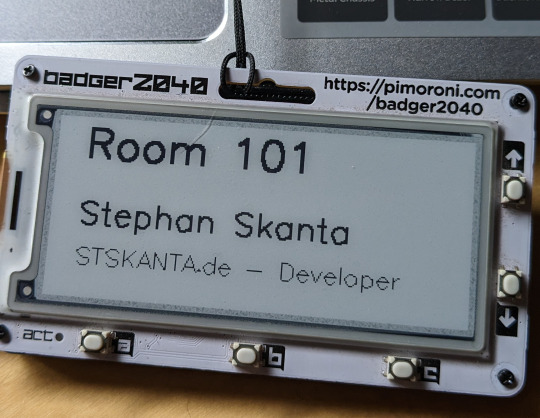
Das was wir hier aktuell durchführen können ist dahingehend leider noch sehr beschränkt. Auch SSH ist keine Option, da das OS des Pico das nicht beherrscht. Es wird also stark davon abhängen wie weiter in dieser Sache entwickelt wird und ob wir hier künftig durch entsprechende Updates des Pico/PicoW OS besonders im Hinblick auf Micropython noch solche Möglichkeiten bekommen werden.
Auf Github ist eine meiner Repositories (https://github.com/techcree/Badger2040.git) zu finden, wo ich mich mit diesem Thema beim Badger2040 auseinander gesetzt habe. Der Ansatz ist dort noch eine html-GUI hinzuzufügen, da TKinter unter Micropython Probleme bereitet. Da der Badger2040 aber kein WLAN kann ;-) ist das hier nicht das richtige Besipiel. Nehmen wir also mal einen Pico W mit einem daran angeschlossenen Display an so wird ein Schuh daraus. Ich denke aber wir stehen hier ggf. kurz vor einer Lösung. Es bleibt also spannend...
0 notes
Text
Banana Pi BPI-PicoW-S3B
Der weit verbreitete Raspberry Pi Pico(W) hat mit dem Banana Pi BPI-PicoW einen interessanten Compagnion bekommen. Baut der Raspberry Pi Pico auf dem ebenfalls von der Raspberry Pi Foundation entwickelten Mikrocontroller RP2040 auf, nutzt der BPI-PicoW einen ESP32-S3 von Espressif. Beides sind Dual-Core Controller mit einer guten Ausstattung an Peripherie. Die folgende Tabelle zeigt die…

View On WordPress
0 notes
Text
Aging Brain Initiative awards fund five new ideas to study, fight neurodegeneration | MIT News
Aging Brain Initiative awards fund five new ideas to study, fight neurodegeneration | MIT News
Neurodegenerative diseases are defined by an increasingly widespread and debilitating death of nervous system cells, but they also share other grim characteristics: Their cause is rarely discernible and they have all eluded cures. To spur fresh, promising approaches and to encourage new experts and expertise to join the field, MIT’s Aging Brain Initiative (ABI) this month awarded five seed grants…

View On WordPress
#Aging Brain Initiative (ABI)#ALS#Alzheimer&039;s disease#amyotrophic lateral sclerosis#Ann Graybiel#Ayano Matsushima#Boston Medical Center#Gloria Choi#immune inflammation#Li-Huei Tsai#McGovern Institute for Brain Research#MIT Department of Brain and Cognitive Sciences#neurodegeneration#Peter Dedon#Picower Institute for Learning and Memory#Ritu Raman#Thomas Heldt#Vivian Sze
1 note
·
View note
Text
by Jessica Costescu
A Massachusetts Institute of Technology faculty member went on an anti-Semitic tirade after the House Committee on Education and the Workforce pressed the school to provide internal documents about its response to the outbreak of anti-Semitism on campus.
A postdoctoral associate working in MIT's Tonegawa neuroscience lab, Afif Aqrabawi, derided the committee chairwoman, Virginia Foxx (R., N.C.), as "a treasonous Zionist tool, a genocide enabler, and a disgusting shit stain of a human," and described other members of the House as "Israeli bootlickers."
Aqrabawi also referred to American politicians as "loyal prostitutes of Netanyahu," lamented the influence of Jewish political groups, and referred to Israelis as "parasites."
"I make it clear your representatives are eager cucks for defense contractors and AIPAC," he wrote. "My words are dangerous because they may alert a distracted American public to the parasites using their country as a host species."
Aqrabawi’s tirade came in the wake of a letter from Foxx to MIT president Sally Kornbluth that panned Kornbluth’s response to several anti-Semitic incidents on campus and pressed the school to provide internal documents shedding light on its policies and code of conduct.
The committee’s letter cited several tweets Aqrabawi sent, including one in which he said Israel "has no future in this world." In other posts highlighted by the committee, the MIT faculty member accused Israelis of "harvesting" the organs of dead Palestinians and called Zionists "Jewish fundamentalists who want to enslave the world in a global Apartheid system."
As a postdoctoral associate in MIT's Picower Institute for Learning and Memory, Aqrabawi earns a minimum salary of $66,950 and works under a "faculty mentor," according to MIT’s website. The head of Aqrabawi's lab is Susumu Tonegawa, a professor of biology and neuroscience.
21 notes
·
View notes
Text
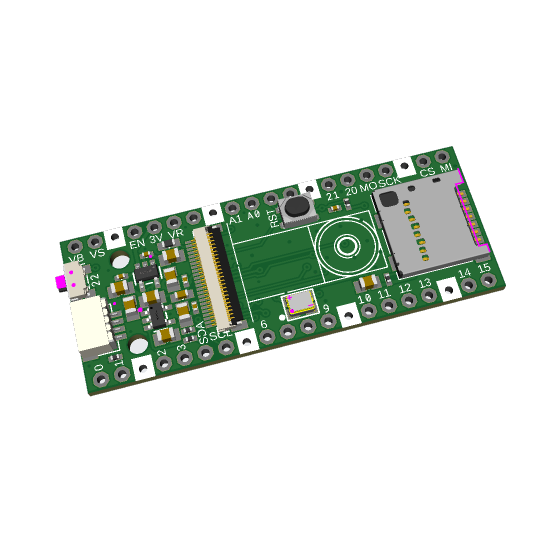
snap snap, here's a camera module picowbell
we've been doing a ton of projects with OV5640-and-friends camera modules. these devices have 8-pin data ports plus pixel clock, hsync and vsync. the data can be raw 565 color, or JPEG data at 1080p! either way, you need a device with lots of RAM and the ability to quickly grab the buffer off the module. the RP2040 will do a fine job, but if you want to work with these modules they require a LOT of wiring. (https://learn.adafruit.com/capturing-camera-images-with-circuitpython/raspberry-pi-pico-wiring)
to make it easier, here's a design for a 'cowbell that will work with the Pico or PicoW to add a camera module, Stemma QT I2C port, MicroSD slot for storing images, and a right angle 'shutter' button. there's not enough room for a display on this slim board but we left pins 20 and 21 available for a TFT CS and DC pin for expansion capabilities.
#raspberry pi#raspberrypiprojects#camera#ov5640#rp2040#adafruit#electronics#opensource#manufacturing#opensourcehardware
4 notes
·
View notes
Text
Atlas of human brain blood vessels highlights changes in Alzheimer’s disease

Atlas of human brain blood vessels highlights changes in Alzheimer’s disease
MIT researchers characterize gene expression patterns for 22,500 brain vascular cells across 428 donors, revealing insights for Alzheimer’s onset and potential treatments.
Your brain is powered by 400 miles of blood vessels that provide nutrients, clear out waste products, and form a tight protective barrier — the blood-brain barrier — that controls which molecules can enter or exit. However, it has remained unclear how these brain vascular cells change between brain regions, or in Alzheimer’s disease, at single-cell resolution.
To address this challenge, a team of scientists from MIT’s Computer Science and Artificial Intelligence Laboratory (CSAIL), The Picower Institute for Learning and Memory, and The Broad Institute of MIT and Harvard recently unveiled a systematic molecular atlas of human brain vasculature and its changes in Alzheimer’s disease (AD) across six brain regions, in a paper published June 1 in Nature Neuroscience.
Alzheimer's disease is a leading cause of death, affects one in nine Americans over 65, and leads to debilitating and devastating cognitive decline. Impaired blood-brain barrier (BBB) function has long been associated with Alzheimer’s and other neurodegenerative diseases, such as Parkinson's and multiple sclerosis. However, the molecular and cellular underpinnings of BBB dysregulation remain ill-defined, particularly at single-cell resolution across multiple brain regions and many donors.
Navigating vascular complexity
Embarking deep into the complexities of our gray matter, the researchers created a molecular atlas of human brain vasculature across 428 donors, including 220 diagnosed with Alzheimer's and 208 controls. They characterized over 22,514 vascular cells from six different brain regions, measuring the expression of thousands of genes for each cell. The resulting datasets unveiled intriguing changes in gene expression across different brain regions and stark contrasts between individuals afflicted with AD and those without.
“Alzheimer's therapy development faces a significant hurdle — brain alterations commence decades before cognitive signs make their debut, at which point it might already be too late to intervene effectively,” comments MIT CSAIL principal investigator and electrical engineering and computer science (EECS) Professor Manolis Kellis. “Our work charts the terrain of vascular changes, one of the earliest markers of Alzheimer's, across multiple brain regions, providing a map to guide biological and therapeutic investigations earlier in disease progression.”
Kellis is the study's co-senior author, along with MIT Professor Li-Huei Tsai, director of the Picower Institute and the Picower Professor in the Department of Brain and Cognitive Sciences.
The little cells that could
The threads of our human brain vasculature, and every part of our brain and body, are composed of millions of cells, all sharing the same DNA code, but each expressing a different subset of genes, which define its functional roles and distinct cell type. Using the distinct gene expression signatures of different cerebrovascular cells, the researchers distinguished 11 types of vascular cells.
These included endothelial cells that line the interior surface of blood vessels and control which substances pass through the BBB, pericytes that wrap around small vessels and provide structural support and blood flow control, smooth muscle cells that form the middle layer of large vessels and whose contraction and relaxation regulates blood flow and pressure, fibroblasts that surround blood vessels and hold them in place, and they distinguished arteriole, venule, and capillary veins responsible for the different stages of blood oxygen exchange.
The abundance of these vascular cell types differed between brain regions, with neocortical regions showing more capillary endothelial cells and fewer fibroblasts than subcortical regions, highlighting the regional heterogeneity of the BBB.
Clues and suspects
Armed with these annotations, the next phase was studying how each of these cell types change in AD, revealing 2,676 genes whose expression levels change significantly. They found that capillary endothelial cells, responsible for transport, waste removal, and immune surveillance, showed the most changes in AD, including genes involved in clearance of amyloid beta, one of the pathological hallmarks of AD, providing insights on the potential mechanistic implications of vascular dysregulation on AD pathology.
Other dysregulated processes included immune function, glucose homeostasis, and extracellular matrix organization, which were all shared among multiple vascular cell types, and also cell-type-specific changes, including growth factor receptors in pericytes, and transporter and energy in endothelial cells, and cellular response to amyloid beta in smooth muscle cells. Regulation of insulin sensing and glucose homeostasis in particular suggested important connections between lipid transport and Alzheimer’s regulated by the vasculature and blood-brain-barrier cells, which could hold promise for new therapeutic clues.
“Single-cell RNA sequencing provides an extraordinary microscope to peer into the intricate machinery of life, and ‘see’ millions of RNA molecules bustling with activity within each cell,” says Kellis, who is also a member of the Broad Institute. “This level of detail was inconceivable just a few years ago, and the resulting insights can be transformative to comprehend and combat complex psychiatric and neurodegenerative disease."
Maestros of dysregulation
Genes do not act on a whim, and they do not act alone. Cellular processes are governed by a complex cast of regulators, or transcription factors, that dictate which groups of genes should be turned on or off in different conditions, and in different cell types. These regulators are responsible for interpreting our genome, the ‘book of life,’ and turning it into the myriad of distinct cell types in our bodies and in our brains. These regulators might be responsible when something goes wrong, and they could also be critical in fixing things and restoring healthy cellular states.
With thousands of genes showing altered expression levels in Alzheimer’s disease, the researchers then sought to find the potential masterminds behind these changes. They asked if common regulatory control proteins target numerous altered genes, which may provide candidate therapeutic targets to restore the expression levels of large numbers of target genes. Indeed, they found several such ‘master controllers,’ involved in regulating endothelial differentiation, inflammatory response, and epigenetic state, providing potential intervention points for drug targets against AD.
Cellular murmurings
Cells do not function in isolation; rather, they rely on communication with each other to coordinate biological processes. This intercellular communication is particularly complex within the cellular diversity of the brain, given the many factors involved in sensing, memory formation, knowledge integration, and consciousness. In particular, vascular cells have intricate interactions with neurons, microglia, and other brain cells, which take on heightened significance during pathological events, such as in Alzheimer's disease, where dysregulation of this cellular communication can contribute to the progression of the disease.
The researchers found that interactions from capillary endothelial cells to neurons, microglia, and astrocytes were highly increased in AD, while interactions in the reverse direction, from neurons and astrocytes to capillary endothelial cells, were decreased in AD. This asymmetry could provide important cues for potential interventions targeting the vasculature and specifically capillary endothelial cells, with ultimate broad positive impacts on the brain.
“The dynamics of vascular cell interactions in AD provide an entry point for brain interventions and potential new therapies,” says Na Sun, an EECS graduate student and MIT CSAIL affiliate and first author on the study. “As the blood-brain barrier prevents many drugs from influencing the brain, perhaps we could instead manipulate the blood-brain barrier itself, and let it spread beneficiary signals to the rest of the brain. Our work provides a blueprint for cerebrovasculature interventions in Alzheimer's disease, by unraveling how cellular communication can mediate the impact of genetic variants in AD."
Going off script: genetic plot twists
Disease onset in our bodies (and in our brains) is shaped by a combination of genetic predispositions and environmental exposures. On the genetic level, most complex traits are shaped by hundreds of minuscule sequence alterations, known as single-nucleotide polymorphisms (or SNPs, pronounced snips), most of which act through subtle changes in gene expression levels.
No matter how subtle their effects might be, these genetic changes can reveal causal contributors to disease, which can greatly increase the chance of therapeutic success for genetically-supported target genes, compared to targets lacking genetic support.
To understand how genetic differences associated with Alzheimer’s might act in the vasculature, the researchers then sought to connect genes that showed altered expression in Alzheimer’s with genetic regions associated with increased Alzheimer’s risk through genetic studies of thousands of individuals. They linked the genetic variants (SNPs) to candidate target genes using three lines of evidence: physical proximity in the three-dimensional folded genome, genetic variants that affect gene expression, and correlated activity between distant regulatory regions and target genes that go on and off together between different conditions.
This resulted in not just one hit, but 125 genetic regions, where Alzheimer’s-associated genetic variants were linked to genes with disrupted expression patterns in Alzheimer’s disease, suggesting they might mediate these causal genetic effects, and thus may be good candidates for therapeutic targeting. Some of these predicted hits were direct, where the genetic variant acted directly on a nearby gene. Others were indirect when the genetic variant instead affected the expression of a regulator, which then affected the expression of its target genes. And yet others were predicted to be indirect through cell-cell communication networks.
ApoE4 and cognitive decline
While most genetic effects are subtle, both in Alzheimer’s and nearly all complex disorders, exceptions do exist. One such exception is FTO in obesity, which increases obesity risk by one standard deviation. Another one is apolipoprotein E (ApoE) in Alzheimer’s disease, where the E4 versus E3 allele increases risk more than 10-fold for carriers of two risk alleles — those who inherited one ‘unlucky’ copy from each parent.
With such a strong effect size, the researchers then asked if ApoE4 carriers showed specific changes in vascular cells that were not found in ApoE3 carriers. Indeed, they found abundance changes associated with the ApoE4 genotype, with capillary endothelial cells and pericytes showing extensive down-regulation of transport genes. This has important implications for potential preventive treatments targeting transport in ApoE4 carriers, especially given the cholesterol transporter roles of ApoE, and the increasingly recognized role of lipid metabolism in Alzheimer’s disease.
"Unearthing these AD-differential genes gives us a glimpse into how they may be implicated in the deterioration or dysfunction of the brain's protective barrier in Alzheimer's patients, shedding light on the molecular and cellular roots of the disease's development," says Kellis. "They also open several avenues for therapeutic development, hinting at a future where these entry points might be harnessed for new Alzheimer's treatments targeting the blood-brain barrier directly. The possibility of slowing or even halting the disease's progression is truly exciting.”
Translating these findings into viable therapeutics will be a journey of exploration, demanding rigorous preclinical and clinical trials. To bring these potential therapies to patients, scientists need to understand how to target the discovered dysregulated genes safely and effectively and determine whether modifying their activity can ameliorate or reverse AD symptoms, which requires extensive collaborations between medical doctors and engineers across both academia and industry.
“This is a tour de force impressive case series,” says Elizabeth Head, vice chair for pathology research and pathology professor at the University of California at Irvine, who was not involved in the research. “A novel aspect of this study was also the methodological approach, which left the vasculature intact, as compared to previous work where blood vessel enrichment protocol was applied. Manolis Kellis and his colleagues show clear evidence of neurovascular unit dysregulation in AD and it is exciting to see known and novel pathways being identified that will accelerate discoveries at the protein level. Many DEGs associated with AD are linked to lipid/cholesterol metabolism, to AD genetic risk factors (including ApoE) and inflammation. The potential for the ApoE genotype in mediating cerebrovascular function will also lead to possible new mouse models that will capture the human phenotype more closely with respect to the vascular contributions to dementia in humans. The regional differences in DEGs are fascinating and will guide future neuropathology studies in the human brain and drive novel hypotheses.”
"The predominant focus in AD research over the past 10 years has been on studying microglia, the resident macrophage-like cells of the brain,” adds Ryan Corces, an assistant professor of neurology at the University of California at San Francisco who was also not involved in the work. “While microglia certainly play a key role in disease pathogenesis, it has become increasingly clear through studies such as this one that vascular cells may also be critically involved in the disease. From blood-brain barrier leakage to an enhanced need for debris clearance, the vascular cells of the brain play an important part in this complex disease. This study, and others like it, have begun picking apart the underlying molecular changes that occur in vascular cells, showing which genes appear dysregulated and how those changes may interact to alter vascular cell functions. Together with the mounting evidence of vascular involvement in AD, this work provides an important foundation for guiding therapeutic interventions against blood-brain barrier dysfunction in AD, especially during the preclinical or prodromal stages of the disease, where the blood-brain barrier may be playing a central role.”
Sun, Kellis, and Tsai wrote the paper alongside Leyla Anne Akay, Mitchell H. Murdock, Yongjin Park, Fabiola Galiana-Melendez, Adele Bubnys, Kyriaki Galani, Hansruedi Mathys, Xueqiao Jiang, and Ayesha P. Ng of MIT and David A. Bennett of the Rush Alzheimer’s Disease Center in Chicago. This work was supported, in part, by National Institutes of Health grants, the Cure Alzheimer’s Foundation CIRCUITS consortium, the JPB Foundation, Robert A. and Renee Belfer, and a Takeda Fellowship from the Takeda Pharmaceutical Company.
Source: MIT
Read the full article
3 notes
·
View notes
Text
3 notes
·
View notes
Text
MIT tops among single-campus universities in US patents granted
New Post has been published on https://sunalei.org/news/mit-tops-among-single-campus-universities-in-us-patents-granted/
MIT tops among single-campus universities in US patents granted

In an era defined by unprecedented challenges and opportunities, MIT remains at the forefront of pioneering research and innovation.
The Institute’s relentless pursuit of knowledge has once again been recognized, with MIT securing 343 utility patents issued by the United States Patent and Trademark Office in 2023. This marks the 10th consecutive year that the National Academy of Inventors has both ranked worldwide colleges for number of U.S. patents issued and recognized MIT as the top single-campus university for patents granted. (The University of California system, which comprises 10 campuses and six academic health centers across the state, is No. 1 overall.)
Technology transfer is at the core of MIT’s mission to advance knowledge for the benefit of the world, and the Technology Licensing Office (TLO) plays a transformative role in bridging the gap between groundbreaking research and societal impact. Impact is recognized in many ways through startups, small- to medium-sized companies, and large corporations. The TLO’s efforts in patenting and licensing are vital for transforming academic discoveries into practical solutions that address societal needs, drive economic growth, and create new opportunities.
Each year, the TLO receives over 600 invention disclosures, resulting in a high volume of issued patents. The TLO’s ongoing strategic licensing efforts bolster MIT’s endeavors across six clear impact areas: healthy living, sustainable futures, connected worlds, advanced materials, climate stabilization, and the exploration of uncharted frontiers. These areas, intentionally curated to reflect the interests and priorities of MIT’s faculty and research staff, drive meaningful change through translation and tech transfer.
Lesley Millar-Nicholson, the executive director of the TLO, further underscores the importance of aligning efforts with President Sally Kornbluth’s vision for MIT. “Our collaborative efforts ensure that the innovations born here at MIT make a difference across the globe, addressing some of the most pressing challenges of our time,” Millar-Nicholson states. “This reflects a shared commitment to what Kornbluth described in her inaugural address about climate change, ‘… [this is] the kind of grand creative enterprise in which the energy you release together is greater than what you each put in. A nuclear fusion of problem-solving and possibility!’”
Verdox and Cognito Therapeutics are two of the many startups that epitomize a grand creative enterprise. Verdox, a startup from the lab of T. Alan Hatton, the Ralph Landau Professor of Chemical Engineering Practice and director of the David H. Koch School of Chemical Engineering Practice, is on a mission to combat climate change by capturing carbon dioxide with unrivaled efficiency using electricity. Cognito, which sprang from the labs of Li-Huei Tsai, professor of neuroscience and director of the Picower Institute for Learning and Memory, and Edward Boyden, the Y. Eva Tan Professor in Neurotechnology and member of the McGovern Institute for Brain Research, pioneers treatments for neurodegenerative diseases, including dementias, offering Alzheimer’s patients a beacon of noninvasive hope with their neuro-stimulatory therapy. These enterprises, just two of many that have licensed and are developing MIT’s intellectual property, embody the spirit of MIT — they are not merely companies; they are catalysts for a more sustainable, healthier world.
Technology Licensing Officer Nestor Franco highlights the daily journey of MIT’s research from concept to commercialization: “Our commitment to out-license these innovations not only amplify MIT’s contribution to global progress but also reinforces our dedication to societal betterment,” he says.
As MIT continues to push the boundaries of what is possible, from deep space to quantum computing, the TLO remains a cornerstone of the Institute’s strategy for impact.
To explore the cutting-edge technologies emerging from MIT, visit patents.mit.edu. Here, you can discover the innovations available for licensing that are set to shape the future. To delve deeper into the work and initiatives of the TLO, and to understand how MIT’s inventions are transformed into societal solutions, visit tlo.mit.edu.
1 note
·
View note
Photo

Raspberry Pi Pico W based home automation #raspberry #raspberrypipico #pipico #picow #electronics #engneering #electronicsprojects #electronicslover #relay #led #automation #homeautomationsystem #homeautomation https://www.instagram.com/p/Coe_OXSvWj-/?igshid=NGJjMDIxMWI=
#raspberry#raspberrypipico#pipico#picow#electronics#engneering#electronicsprojects#electronicslover#relay#led#automation#homeautomationsystem#homeautomation
1 note
·
View note
Text
Create an access point with the Raspberry Pi Pico W, serve a web-page and flash the LEDCreate an access point with the Raspberry Pi Pico W, serve a web-page and flash the LED
Following various examples, I’ve created a MicroPython script that does the following:
Create an access point on the Raspberry Pi Pico W.
Create a web server.
Serve a simple page on that web server.
Toggle/flash the on-board LED when that page is loaded/refreshed.
TL;DR – see the code here
Download MicroPython and install it
First of all, you’ll need to download the latest MicroPython UF2. The…

View On WordPress
1 note
·
View note
Text
Raspberry Pi und Raspbi PicoW + Sensoren (2/2)
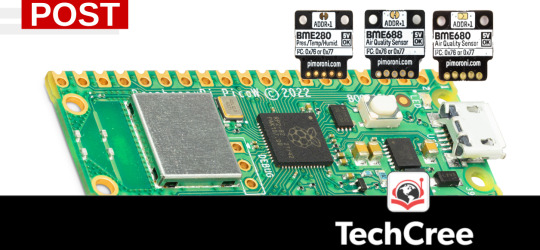
Jetzt geht's um den Raspberry Pi PicoW (WLAN) und den BME280 Sensor.
Im ersten Teil dieser kleinen Beitragsserie sind wir insbesondere auf den BME680 bzw. 688 eingegangen. Diese beiden Sensoren eignen sich aber aktuell nicht für die Verwendung in verbindung mit dem Pico oder PicoW wegen der noch fehlenden Bibliothek für Micropython. In Verbindung mit dem Raspberry Pi 4 bspw. läufen sie aber prima.
Für den Pico und auch den PicoW allerdings bitet sich der BME280 an. Hierzu findet Ihr bspw. in der Verwendung mit der ThonnyIDE und im Menü PlugIns Installieren unter Suche von BME280 auch die "micropython-bme280" Bibliothek (siehe Bild in Position 3).
Nicht vergessen! Um die "Libary" installieren zu können muss der Pico verbunden sein, denn die Lib muss direkt auf den Pico geschrieben werden können. Bevor wir weiter fortfahren nochmal der Hinweis: Dieser Beitrag enthält kostenlose und unbezahlte Werbung!
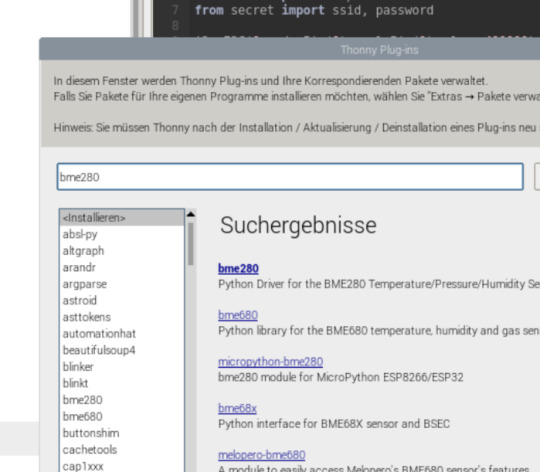
Angschlossen an den PicoW habe ich den Sensor dann wie folgt: Je vom BME280 ausgehend auf die GP's des PicoW -> SDA an GPIO 0, SCL an GPIO1, 2-5V an Pin 36 und GND an den dreiiten GND GP-Pin rechts. Der Sensor Breakout ist gut beschriftet und es empfiehlt sich Pins anzulöten sofern ihr nicht einen Breakout Garden oder ähnliches verwendet. Dazu später mehr.
Dieser Sensor liefert uns Daten über Temperatur, Luftfeuchtigkeit und Luftdruck. Ihr dürft allerdings nicht vergessen, dass es ggf. einige Einflüsse gibt die eine ganz genaue Messung so nicht möglich machen. Die Infos die wir also vom Senso erhalten sind ggf. mit etwas Vorsicht zu betrachten. Wer also nicht gerade tausendprozentig korrekte Werte erwartet bekommt mit dem Sensor aber ein tolles Stück technik zum kleinen Preis.
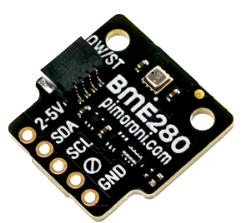
Auf die Betankung des PicoW mit dem passenden .uf2 File und die generelle Erstinbetriebnahme etc. gehe ich hier an der Stelle nicht im Detail ein. Es gibt dazu auf der Website von Raspberry Pi umfangreiche Infos und zahlreiche Tutorials im Web und auch insbesondere auf YouTube.
Je nach Lieferant könnt ihr den PicoW auch mit bereits verlöteten Pinleisten oder eben ohne bekommen. In der Regel kommt der Pico und PicoW aber ohne verlötete Pinleisten. Das aber nur am Rande. Also bei der Bestellung darauf achten oder entsprechendes Zubehör eben gleich mitbestellen.

Wie ihr auf dem Bild sehen könnt verwende ich eine GPIO Erweiterungsplatte bei der die GPIOs dann aber gegenüber dem Pico im Original spiegelverkehrt dargestellt werden. Wie bereits kurz angesprochen gibt es sogenannte Breakout Garden. Solltet ihr im Besitz von soetwas sein braucht ihr den BME280 nicht verlöten bzw. dürft den dann auch nicht mit PINs verlöten. Hier wird der BME280 und eben auch andere Breakouts einfach gesteckt.
Es kommt letztlich darauf an wie fest eure installation bzw. eurer Projekt auf Dauer ausgelegt werden soll. Natürlich könnte man auch eine riekte Verlötung zwischen PicoW und dem Breakout herstellen und noch ein schönes Gehäuse dazu mit dem 3D Drucker erstellen. Also beispielsweise wenn ihr dauerhaft den PicoW als kleine Messstation irgendwo einsetzen möchtet. Wenn ihr aber noch weitere Projekte plant und immer mal was Neues ausprobieren möchtet sind solche Lösungen, wie der Breakout Garden dafür natürlich super geeignet.
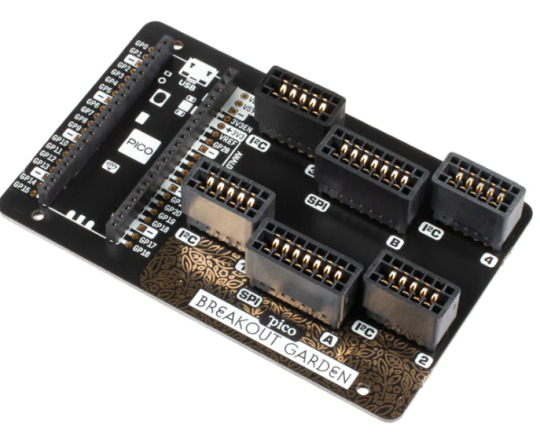
Übrigens handelt es sich um den hier abgebildeten (Bildquelle: Pimoroni.com) um den Pimoroni Breakout Garden. So genug von der Seite, kommen wir nun mal zum Progrmmieren. Es gibt natürlich noch andere Wege als mit Micropython, doch für viele hat sich Micropython in Verbindung mit diesen Microcontrollern von Raspberry Pi schlicht als vorteilhafter erweisen. Gerade auch weil der Bezug zu Python so eng ist. Wenn wir die Verbindung zum PicoW über die ThonnyIDE hergestellt haben, die Libary installiert haben und unsere Micropython Scripte geschrieben haben sieht das ganze dann etwa so aus.
Dabei empfehle ich die Zugangsdaten eures WLAN's in einer gesonderten Datei abzulegen und euch diese Daten dann im hauptscript reinzuladen. In meinem Fall nennt die sich secret.py in der die Zugangdaten meines WLAN's zu finden sind. Der Befehl sich dann in der main.py, also dem eigentlichen auszuführenden Script zu importieren lautet dann: "from secret import ssid, password". Das ziel ist es aber nicht nur die reinen Sensordaten aus dem Senso auszulesen, sondern eine Website zu haben über die wir die Messergebnisse anzeigen wollen.
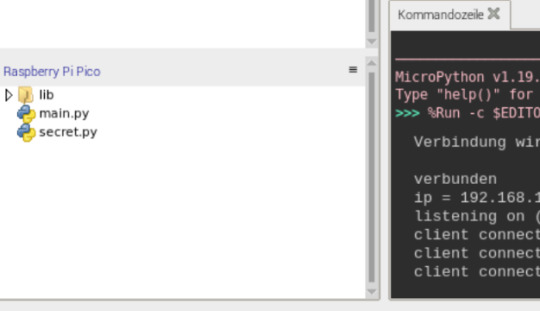
Wir müssen den PicoW also einmal sich mit dem heimischen WLAN verbinden lassen, die Zugangsdaten dazu verarbeiten, die Sensordaten auslesen und eine Website anzeigen. Da der PicoW wenn er erfolgreich sich mit dem WLAN verbunden hat eine IP Adresse bekommt, könnt ihr dann im Browser eben diese IP Adresse einfach in der URL-Leiste eingeben und euch die Website die vom PicoW erzeugt wird aufrufen.
Noch ein kleiner Tipp: Wenn ihr keine festen IP Adressen an eure Endgeräte vergebt, sonder eben DHCP aktiviert habt, so kann es sein, dass der PicoW jedesmal wenn ihr euch verbindet eine andere IP Adresse bekommt. Im Fall meiner Fritzbox 7590 kann ich aber einstellen, dem PicoW möglichst immer die gleiche IP Adresse zuzuteilen auch unter DHCP. Das macht es dann etwas einfacher. Und nochmal - nie mischen! Keine Endgeräte auf denen feste IP Adressen konfiguriert sind an einem Router betreiben der auf DHCP läuft. Das kann ziemlich schiefgehen. Im schlimmsten Fall schießt ihr euch den Router ab oder bringt ihn zum stehen.

Der große Vorteil des PicoW ist die WLAN Funktionalität, dank des auf dem Board festverbauten WLAN Moduls. So lässt sich der PicoW als Mini-Webserver betreiben. Es gibt auch hier verschiedenen Möglichkeiten das zu nutzen. Ich gehe später noch dazu kurz auf Phew ein um euch den Unterschied zu verdeutlichen. In meinem aktuellen Beispiel ist aber der html-Code im Pythonscript eingebaut. Am Ende bekommen ich so nachfolgende Website die sich in regelmäßigen Abständen aktuallisiert und dann auch jeweils die aktuellen Messwerte anzeigt.
Genau an dem Punkt ist es etwas Trickreich, denn ihr müsst dafür sorgen dass durch die Herstellung der Verbindung zum WLAN und dem Anzeigen der Messdaten kein Konflikt entsteht. Den vollständigen Code findet ihr auf meinen GitHub Seiten unter: https://github.com/techcree/PiPicoW
Ihr findet aber auch sonst im Netz sicher viele Beispiele dieser Art und schaut einfach was für euch da am Besten passt. Es ist eine tolle Sache, dass viele wie auch in meinem Fall Code kostenlos und freinutzbar zur Verfügung stellen. Dieser dann verändert und angepasst wird und wiederum zur Verfügung gestellt wird. So stehen im Lauf der Zeit zahlreiche version für allerlei Anwendungen zur Verfügung und das ist eine prima Sache. Und genau hier ist GitHub auch eine der in meinen Augen besten Plattformen für diese Zwecke.
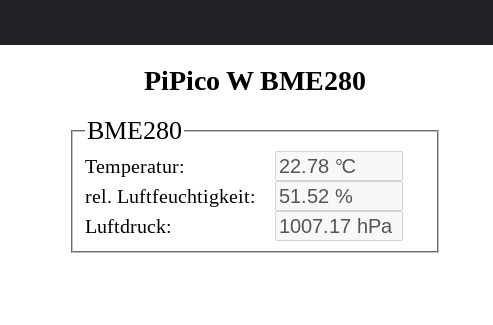
Noch eine kleine lustige Geschichte zum Schluss! Ziemlich bekannt ist der Robotmaker und YouTuber Kevin McAleer. Ich hatte bereits in anderen Projekten schon immer wieder Kontakt zu ihm und anderen in diesem Umfeld. Bei einem seiner Beiträge hatte ich über den Chat das Thema Phew angesprochen. Dabei handelt es sich um einen alternativen Weg bei dem die .html Seite von hauptscript getrennt werden kann. Es ist im Prinzip eine Webserver Architektur, die euch zudem noch einiges mehr ermöglichen kann.
Zum Thema Phew in Verbindung mit dem Raspberry Pi PicoW und dem BME280 Sensor hatte ich speziell hier Kevin angesprochen ggf. bei nächster Gelegenheit einmal ein extra Video zu machen. Kevin McAleer fand die Idee rehct gut und wir schauen mal ob er es zeitlich schafft. Er ist da einfach in Sachen YouTube ein richtiger Profi und ich könnte euch das garnicht so cool rüberbringen wie er das kann.

Das Video über das ich hier spreche findet ihr übrigens auf seinem YouTube Kanal. Ich wünsch euch an der Stelle viel Spaß mit dem PicoW und ggf. auch mit diesem ganz konkreten Projekt.
#Pimoroni#raspberry pi picow#kevin mcaleer#raspberry pi#microcontroller#bme280 sensor#microphython#temperatur messung#Luftdruck messung#Luftfeuchtigkeit messung#chromebook programmierung#thonnyIDE
0 notes
Quote
A pair of early-stage clinical studies testing the safety and efficacy of 40-hertz sensory stimulation to treat Alzheimer’s disease has found that the potential therapy was well-tolerated, produced no serious adverse effects, and was associated with some significant neurological and behavioral benefits among a small cohort of participants.
“In these clinical studies we were pleased to see that volunteers did not experience any safety issues and used our experimental light and sound devices in their homes consistently,” says Li-Huei Tsai, the Picower Professor in the the Picower Institute for Learning and Memory at MIT and senior author of the Dec. 1 paper describing the studies in PLoS ONE. “While we are also encouraged to see some significant positive effects on the brain and behavior, we are interpreting them cautiously, given our study’s small sample size and brief duration. These results are not sufficient evidence of efficacy, but we believe they clearly support proceeding with more extensive study of 40-hertz sensory stimulation as a potential noninvasive therapeutic for Alzheimer’s disease.”
Small studies of 40-hertz sensory stimulation confirm safety, suggest Alzheimer’s benefits | MIT News | Massachusetts Institute of Technology
1 note
·
View note
Text

📢 Calling all #RaspberryPi enthusiasts! Explore a wide range of #RPi series models with unbeatable prices at #Elecrow. Visit now and bring your projects to life.🚀 #PicoW #RPI5
📌 https://www.elecrow.com/mcu/raspberry-pi.html?cat=123_raspberry-pi-main-board?utm_source=tumblr&utm_term=idd=2
1 note
·
View note
Photo

Flimsy Protection
APOE is a protein that carries fat in the blood. There are different genetic versions of APOE, and people who inherit one or two copies of the APOε4 (APOE4) form have a higher risk of developing Alzheimer’s disease than people with other forms of the protein, such as APOε3 (APOE3). How a fat-carrying protein contributes to brain problems has been a mystery, but scientists recently found a clue. The brain’s neurons are coated with a fatty substance called myelin, which both protects the cells and enables their high-speed firing. Studies of postmortem brains show people with APOE4 (bottom row) have less myelin (dark staining) than people with APOE3 (top row), suggesting the APOE4 neurons may be more prone to failure and degeneration. In mice, scientists have been able to fix APOE4’s shortcomings – improving neuronal myelination and the animals’ learning and memory – providing a glimmer of hope for future clinical intervention.
Written by Ruth Williams
Image from work by Joel W. Blanchard, Leyla Anne Akay, Jose Davila-Velderrain and Djuna von Maydell, and colleagues
Picower Institute for Learning and Memory, Massachusetts Institute of Technology, Cambridge, MA, USA
Image copyright held by the original authors
Research published in Nature, November 2022
You can also follow BPoD on Instagram, Twitter and Facebook
46 notes
·
View notes